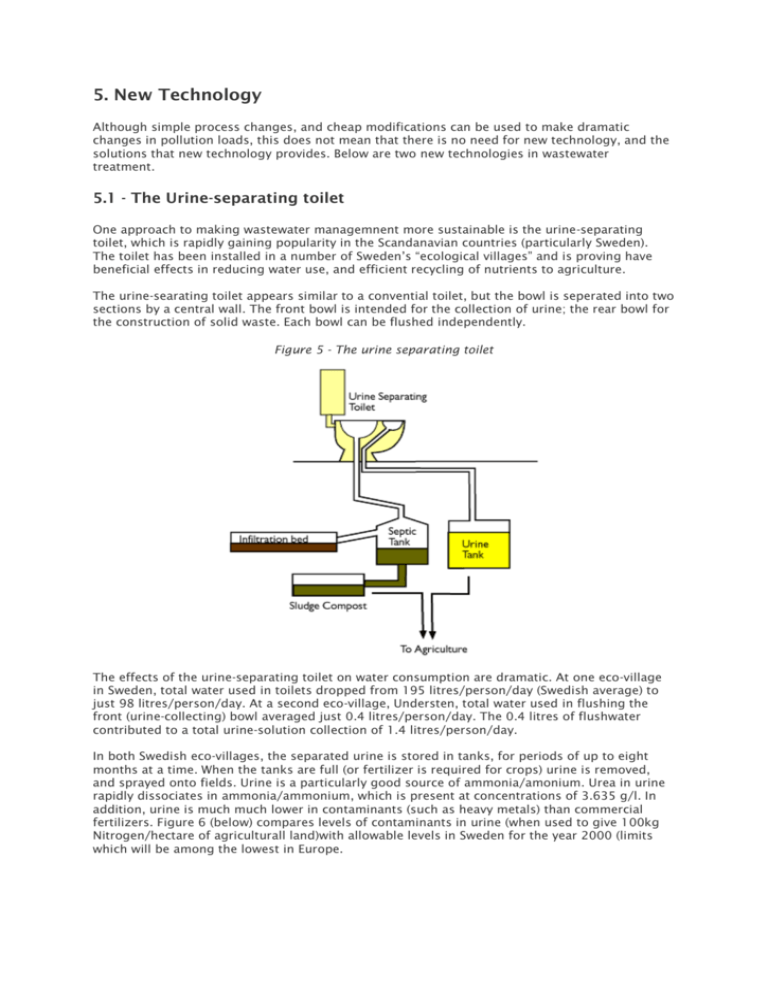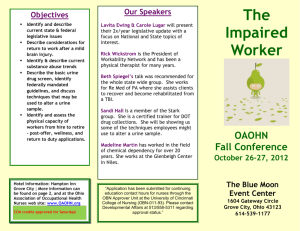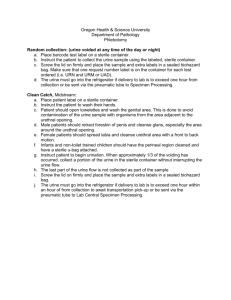5.1 - The Urine-separating toilet
advertisement

5. New Technology Although simple process changes, and cheap modifications can be used to make dramatic changes in pollution loads, this does not mean that there is no need for new technology, and the solutions that new technology provides. Below are two new technologies in wastewater treatment. 5.1 - The Urine-separating toilet One approach to making wastewater managemnent more sustainable is the urine-separating toilet, which is rapidly gaining popularity in the Scandanavian countries (particularly Sweden). The toilet has been installed in a number of Sweden’s “ecological villages” and is proving have beneficial effects in reducing water use, and efficient recycling of nutrients to agriculture. The urine-searating toilet appears similar to a convential toilet, but the bowl is seperated into two sections by a central wall. The front bowl is intended for the collection of urine; the rear bowl for the construction of solid waste. Each bowl can be flushed independently. Figure 5 - The urine separating toilet The effects of the urine-separating toilet on water consumption are dramatic. At one eco-village in Sweden, total water used in toilets dropped from 195 litres/person/day (Swedish average) to just 98 litres/person/day. At a second eco-village, Understen, total water used in flushing the front (urine-collecting) bowl averaged just 0.4 litres/person/day. The 0.4 litres of flushwater contributed to a total urine-solution collection of 1.4 litres/person/day. In both Swedish eco-villages, the separated urine is stored in tanks, for periods of up to eight months at a time. When the tanks are full (or fertilizer is required for crops) urine is removed, and sprayed onto fields. Urine is a particularly good source of ammonia/amonium. Urea in urine rapidly dissociates in ammonia/ammonium, which is present at concentrations of 3.635 g/l. In addition, urine is much much lower in contaminants (such as heavy metals) than commercial fertilizers. Figure 6 (below) compares levels of contaminants in urine (when used to give 100kg Nitrogen/hectare of agriculturall land)with allowable levels in Sweden for the year 2000 (limits which will be among the lowest in Europe. Figure 6 - Urine as a fertilizer Another of advantage in using urine as a fertilizer, is that much of the urine is available to plants directly as ammonia/ammonium. This is not the case with mineral fertilizers. The separation of urine from solid waste, allows the solid waste to treated usefully also. At Björsbyn eco-village in Swedne, the solid waste passes through a septic tank and into a sludge composter. Sludge is removed from the composter, dried, frozen and composted further. After this treatment, it is then suitable for use on fields as fertilizer and as a soil enricher. 5.2 “New Generation” Reed Bed Filters in France [This section taken from the report on Constructed Wetlands] Since the 1980s, French researchers have investigating the use of Reed Bed Filters (RBFs) to treat sewage from small communities. Currently, there are 15 RBF systems in France, each treating waste from populations from 100-250 people (p.e) each. The systems are capable of receiving raw sewage (usually screened to < 2cm). They typically comprise several Type A (primary treatment, 1.15 m2/p.e) and 2 Type B (secondary treatment, 1.05m2/p.e) filters. Variant systems sometimes use 1 Type C (horizontal) filter instead of a second Type B. Figure 7 - New Generation Reed Beds Typically there are a number of Type A filters. Each is loaded with waste for 3 to 4 days, before being rested for 6 to 8 days. These rest periods are critical to the functioning of the system; they allow mineralisation of Total Suspended Solids and maintain aerobic conditions in the gravel and rhizomes. After 15 months of operation a detailed examination of the Montromant plant was undertaken over 48 hours. During the period of testing, temperatures varied from -8.5°C to +6.5°C . The results of the experiment showed the system to be highly effective at improving water quality (see Table 2) Table1 - Performance of New Generation Reed Bed Systems (conc. in mg/l) Total COD d COD BOD5 TSS TP PPO4 TKN Raw Sewage 495 190 215 225 8.5 6.4 42.8 Filter A outflow 92 70 0 18 5.8 5.3 19.6 Final Outflow 58 40 16 12 5.6 5.1 10.1 Removal (%) 87.5 80 92.5 94.5 40 28 76 The application of raw waste to the A-type filters was shown to result in sludge accumulation of 1.5 cm/year, however this accumulation has not been shown to inhibit breakdown of waste, even at sludge-heights of 15 cm. Nevertheless, accumulation of such sludge should be allowed for in design of tank height (if it is not to be removed manually at a later stage). 6. Conclusions The field of wastewater treatment, and its sustainability is a large and complex one. In this report, spome of the key areas of interest have been identified and discussed. This discussion is at a broad level, and more technical detail is available about most aspects covered. Please feel free to contact me by email for more information.






